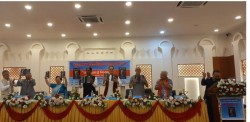Books
By Jivesh Jha
Nepalma Nyayik Samiti: Najikbata Niyalda – roughly translated as Judicial Committees in Nepal: A Closer Look – is jointly written by a judge at the Supreme Court Til Prasad Shrestha and Namit Wagley, Deputy Program Director at The Asia Foundation. The book provides a concise introduction to Nepal’s local governance system, procedure and working of the Judicial Committees and their significance in addressing the concerns and disputes of the people at local level. The book has seven chapters. Each critically investigates the key issues, principles and themes on local government, exercise of judicial powers at local level and global precedents.
The book is published by Nepal Law Society.
The authors believe that the ambitious goal of decentralization has been consolidated by the 2015 Constitution, which is a step in right direction in transforming the country from unitary system of governance to a federal democracy. The Constitution provides for formation of a JC in every local body to adjudicate matters of disputes at the local level. This arrangement is a formal, at the same time, an informal mechanism for dispute settlements. The deputy mayor of a municipality or vice chair of a Village Council shoulders the responsibility to dispense justice at the local level. The JC can refer cases of certain nature to a district court of mediation centre for the formal adjudication.
The authors argue that the legal arrangement to deploy deputy mayor or vice chair tends to frustrate the doctrine of separation of power. As they are elected representatives, their role at JC could be, at times, influenced and their independency in decision-making process could be at stake.
Shrestha and Wagley believe that all the local bodies should be on the same page regarding the procedures and working of the JC. In building a common understanding as to the working and adherence to procedures, the central government could appear in the role of facilitator by taking help from the umbrella organizations of the local units.
The authors rightly believe, in executing judicial powers at local level, there has to be close cooperation amongst all stakeholders, including the Ministry of Federal Affairs and Local Development, the Ministry of Law, Justice and Parliamentary Affairs, the Supreme Court, the district Courts and mediation centres. If this could happen, the actual complexities faced by the local executives on ground could be addressed at policy level.
However, the JCs are not like any court of law, in that they are neither governed by the Judicial Council, nor do they see judges in the role of adjudicators. Article 127(2) and Schedule-VIII of the constitution recognize the JC and empower the government to adopt other alternate dispute settlement mechanism at local level. The authors suggest that there could be a special law on mediation exclusively for local bodies. The cases relating to domestic violence or gender based violence deserve to be settled with external assistance. As these types of cases could have far reaching consequences, it would be imperative to seek cooperation from other governmental agencies, judicial departments and other social institutions.
Firstly, Law Officers appointed at the JC should be given proper capacity building trainings. Secondly, the JC should have a separate set up for hearing the cases. Along with these, the mediators should be well trained. There should be arrangements for police mechanism to implement the decisions passed by JC, suggest authors.
In the first chapter, the authors provide introductory remark and historical backgrounds about the local bodies in Nepal. Section 47(1) of the Act, 2017 empowers the JC to dispense as many as 13 types of disputes, including that of petition regarding non-payment of daily wages; disputes over arrears of rent of up to 2.5 million or petition of senior citizens in regard to their non-care, while Section 47(2) provisions that the JC could refer some 11 types of disputes, including defamation, matrimonial disputes, and trespass, to mediation centre. Still, an aggrieved party could challenge the decision of JC by filling an appeal before the district court and again, if a party remains dissatisfied with the ruling of the district court, s/he has an option to challenge the verdict in the High Court.
Historically speaking, Village Panchayat Act, 2018 BS had empowered the local bodies to settle certain types of disputes. The 1990 Constitution was silent on alternate dispute settlement mechanism at local level. However, Village Development Committee Act, 2048 BS empowered the local bodies to adjudicate certain specified nature of disputes. In addition, Local Self-governance Act, 2055 BS strengthened local units for resolving disputes. The Act, 2055 empowered the local bodies to adjudicate matters relating to land encroachment, forced labour and among others. This law brought a significant change in the local bodies’ regime. Most importantly, this law, for the first time, envisaged that a 3-member body of Mediation Committee would have power to adjudicate local disputes. Nevertheless, the local bodies never implemented the judicial powers conferred upon them. The Mediation Act, 2068 BS and Mediation Regulation, 2070 BS provisioned strong legal basis for the amicable settlement of disputes. Under these laws, Mediation Council has been established to oversee and regulate the mediation at national and local level. The 2015 Constitution of Nepal under Article 217 and Schedule VIII provides for mediation. Over and above all this, the government has adopted and enacted a special law, called Local Government Operation Act, 2074 BS (2017) that deals with the legal arrangements for the local bodies, including the JCs.
In second chapter, the authors have discussed the judicial powers of the local bodies. Section 27 of the Act, 2017 provides that no person shall construct a permanent structure (i.e. house) without passing the proposed design (map) of the house from the concerned local body.
Section 37 empowers the local bodies to take action against the person, who is found to have constructed permanent structure, without taking approval for the same through the proposed design of the house. Under Section 39(5) of the Act, 2017, the local bodies are empowered to levy a fine of up to NPR 500,000/- or pass an order for the demolition of the (disputed) structure so built without passing the design. Also, there could be fine of up to NPR 200,000/- or order for the demolition of the structure built in contrast to the design passed by the local body.
In the third chapter, the authors have discussed the provisions regarding composition and procedure of the JCs. In case of mediation, Section 47(2) of the Act, 2017 provisions that ases referred in mediation should be disposed within three months. If disputes cannot be resolved through mediation, then the JC would have to refer the matter to the concerned district court.
In the fourth chapter, the authors have discussed the advantages of the exercise of judicial powers by the JCs. The practice of settling disputes at local level is not a novel concept in Nepal.
The authors cite an example of Bangladesh to substantiate their claims that JCs are one of the best mechanisms for alternative dispute settlement. As per the report of UNDP, the Rural Courts of Bangladesh have disposed 78 per cent of the cases out of a total of 85000 cases registered with them in 2010.
In the fifth chapter, the authors have thrown light on the matters to be taken into consideration while exercising judicial powers by the JCs. Yet, there are some unaddressed challenges and issues. To mention a few here, there is no clarity as to who will exercise judicial powers at the instance of dissolution or non-existence of JCs. Also, the law is not clear regarding the format of petition or registration procedures or the format of a written statement or the procedures to be followed to condone the delays and non-appearance of a party on a stipulated date. Neither is the law clear about whether the hearing of court or JC will prevail at the instance when a party is in mediation process before the JC, while the other in the court.
There appears ambiguity at policy level too. There is a policy level vacuum regarding the procedure of supervision and monitoring of the JCs by the district courts. Also, the legal arrangements are not enough for implementing the decisions of JCs reached by way of mediation. Currently, mediation law is a central legislation in Nepal. There is a dire need of enacting mediation law suiting the local context and issues. The policy level mechanism is yet to give a green signal to local bodies to appoint the required number of staff at their own discretion.
The JCs have power to look into civil cases and criminal complaints punishable with up to one year of jail sentence. Though the law bestows ample power on the JCs to adjudicate matters of disputes, it’s yet to provide robust mechanism for implementing the decisions passed by the Committees, the authors argue.
In sixth chapter, the authors have discussed strategies to be adopted in exercise of the judicial rights. It is critical to monitor JCs and community needs within each local context for an evidence based approach to inform policy decisions and maximize impacts. In this chapter, the authors suggest ways for the reformation in existing legislation. From inclusive composition of JCs to capacity building schemes, to enactment of laws, to allocation of adequate resources; the authors have stressed the need for bringing reformation under the prevailing laws for the effective implementation of local self-governance.
In addition to this, there should be introduction of electronic case management platforms and switchover to technology in entire business of JCs.
The seventh chapter of the book gives conclusion. The authors argue that there are high expectations on governance to be more responsive and effective, allowing for inclusive economic development. The lack of progress in state reform has created confusion over the roles and responsibilities of the various tiers of the government, including JCs at the local level.
If there is one reason to read Justice Shrestha and Wagley’s timely exposition is their endeavours to give conceptual clarities on the local governance system, Judicial Committees, and their roles in a democracy. They do not only discuss Nepal’s perspective on local government system but also devotes a good deal of section for international precedents. Their book should be a mandatory reading for journalists covering local governance, judges, judicial officers, teachers and students of various streams, including that of social sciences and law.
(The author, formerly a Lecturer of Law at Kathmandu University School of Law, is currently a Judicial Officer at Dhanusha District Court, Janakpurdham)






